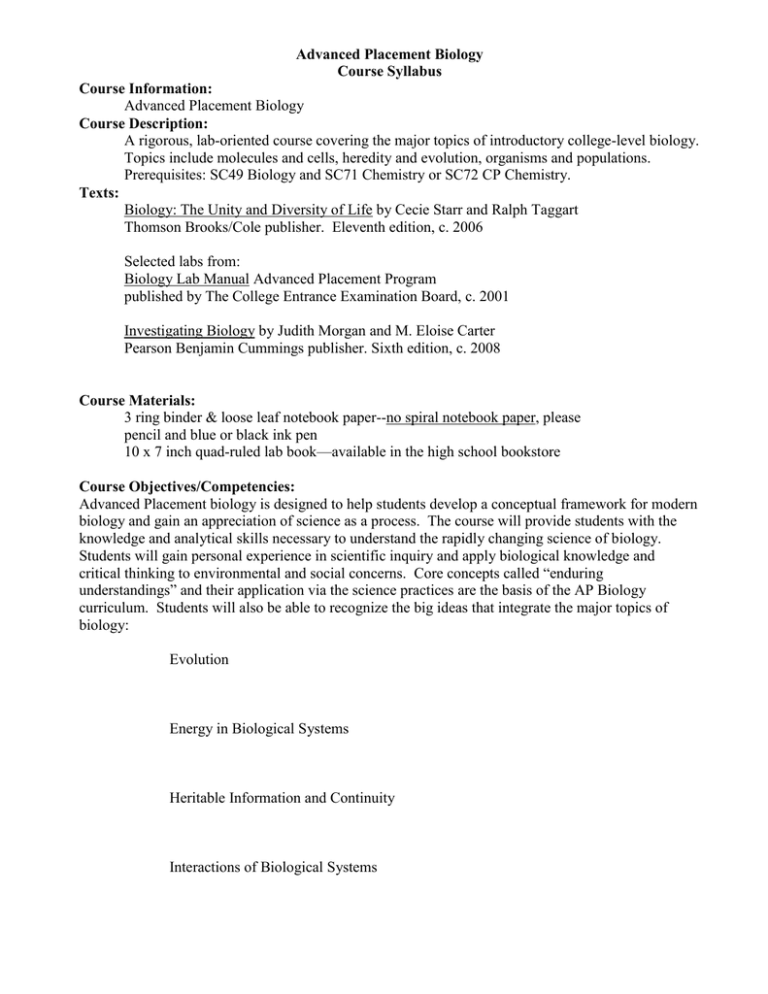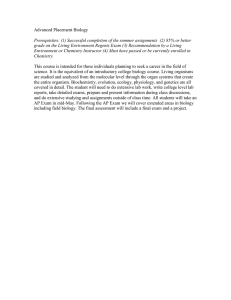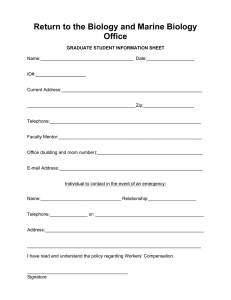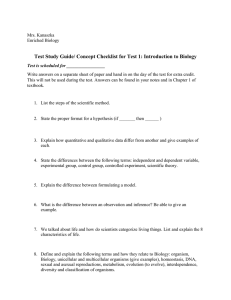Document 15536702
advertisement

Advanced Placement Biology Course Syllabus Course Information: Advanced Placement Biology Course Description: A rigorous, lab-oriented course covering the major topics of introductory college-level biology. Topics include molecules and cells, heredity and evolution, organisms and populations. Prerequisites: SC49 Biology and SC71 Chemistry or SC72 CP Chemistry. Texts: Biology: The Unity and Diversity of Life by Cecie Starr and Ralph Taggart Thomson Brooks/Cole publisher. Eleventh edition, c. 2006 Selected labs from: Biology Lab Manual Advanced Placement Program published by The College Entrance Examination Board, c. 2001 Investigating Biology by Judith Morgan and M. Eloise Carter Pearson Benjamin Cummings publisher. Sixth edition, c. 2008 Course Materials: 3 ring binder & loose leaf notebook paper--no spiral notebook paper, please pencil and blue or black ink pen 10 x 7 inch quad-ruled lab book—available in the high school bookstore Course Objectives/Competencies: Advanced Placement biology is designed to help students develop a conceptual framework for modern biology and gain an appreciation of science as a process. The course will provide students with the knowledge and analytical skills necessary to understand the rapidly changing science of biology. Students will gain personal experience in scientific inquiry and apply biological knowledge and critical thinking to environmental and social concerns. Core concepts called “enduring understandings” and their application via the science practices are the basis of the AP Biology curriculum. Students will also be able to recognize the big ideas that integrate the major topics of biology: Evolution Energy in Biological Systems Heritable Information and Continuity Interactions of Biological Systems Course Outline: school week week 1,2,3 weeks 4,5,6 weeks 7,8,9 Unit Science of Biology, Chemistry of Life Cells weeks 10-14 Cellular Energetics (midterm exam) Heredity weeks 15-18 Molecular Genetics weeks 19-21 Evolutionary Biology (semester final exam) Reproduction, Growth, and Development Adaptations weeks 22-24 weeks 25-26 weeks 27-28 weeks 29-31 weeks 32-36 weeks 37-38 Plants (midterm exam) Body Systems Labs diffusion, osmosis enzymes, pH cell types mitosis respiration photosynthesis molecular biology population gen. transformation restriction enzymes Hardy-Weinberg artificial selection meiosis fruit fly life cycle animal behavior plant anatomy transpiration nervous control; immunity Ecology & Test Review dissolved oxygen; (AP Bio Exam May) symbiosis Aquaponics ecosystem lab (final exam) Grading System: Grades will be assigned based on the student’s earned percentage of points available from class participation, assignments, labs, quizzes and tests. No extra credit or curving of grades is allowed. The following is the grading scale: A=90%-100% semester grades will be calculated accordingly: B=80%-89% 1st nine weeks 40% C=70%-79% 2nd nine weeks 40% D=60%-69% final exam 20% F=below 60% Class Policies: Attendance: Students are expected to be on time, in class and ready to work every time the class meets. Work missed due to an unexcused absent will not receive credit. It is the responsibility of the student to get any assignments missed due to an excused absence and turn these in on time. Students have one day for every excused day absent to turn in work that was assigned while they were absent. Students will be swept who are not in the classroom when the bell rings. Students that are swept must see the teacher prior to school starting the next day in order to have the opportunity to make up work. Make up will not be allowed for tests and quizzes missed due to sweep. Material that is covered in class is important. Students need to be in class, attentive and actively participating every class period. Each student will have only one emergency hall pass each quarter. A valid student id. and student sign-out will be required to use the hall pass. Assignments, Quizzes and Tests: All assignments are due no later than 3:00 pm of the assigned date. These will include essays, reading questions, abstracts, and lab reports. Late work will not be accepted. Not doing an assignment leads to poor performance in class. Please stay on top of things; don’t fall behind by not doing assignments. All assigned material is designed to help the student learn biology. While not all assignments will be collected and graded, all assignments should be completed accurately and kept in the student notebook. Quiz and test questions will be taken from the assigned material. Students will have the responsibility of keeping track of assignments and academic progress using their biology notebook. Notebook: Each student is required to keep a three-ring binder as a notebook for the class. The notebook will contain the objectives and assignments, in order, for each unit. Assignments will be neat and kept in the proper sequence. A good quality notebook will be very useful for completing homework and preparing for tests. Science Philosophy This biology class is designed to challenge all students to develop critical thinking skills and specific science skills in meeting the required 25% of instructional time doing hands-on laboratory work. An emphasis will be placed on science as a process and the importance of evolution as a major foundation of modern biology. Students will be expected to understand the role of science and higher level thinking in solving critical environmental and social issues facing our modern society. Through diligent and consistent effort students will come away from the class with a conceptual framework of modern biological knowledge, trained as better problem solvers and more informed members of the biosphere. Class Behavior: Here are some simple guidelines for class behavior: be honest always contribute positively to the learning environment be respectful (of yourself, others, and the facilities) do your best, challenge yourself be prepared for academic work during class In order to get the most out of class show up ready to work and participate fully in the activities presented. Remember all school policies and rules also apply. Leave at home all items that disrupt the learning environment. Remember no food or drinks in the science lab and only bottled water is allowed in the classroom. Communication: Please feel free to discuss any concerns or questions with me directly. It is my hope that each student is successful and enjoys this year of science. I am available nearly every day either before school, at lunch, or after school. I encourage any students that need extra help to stop by. I look forward to a rewarding and successful year of biology. AP Biology Unit Reading Topics CHEMISTRY OF LIFE UNIT water polarity & H+ bonding cohesive behavior, moderate temperature, expands when frozen, universal solvent acids & bases organic molecules in organisms carbon & carbon bonding chemical groups: hydroxyl, carbonyl, carboxyl, amino, sulfhydryl, phosphate, methyl macromolecules: carbs, proteins, lipids, nucleic acids free energy changes energy and thermodynamics free energy changes ATP and cellular work enzymes lower energy barriers regulation of enzymes CELLS UNIT prokaryotic and eukaryotic cells microscopy prokaryotes structure & function reproduction nutrition & metabolism phylogeny role in biosphere impact on humans eukaryotes basic structure organization of eukaryotes membranes structure: fluid mosaic model selective permeability passive & active transport endo & exocytosis subcellular organization internal membranes nucleus & ribosomes organelles extracellular connections cell cycle and its regulation stages of the cell cycle mitosis molecular control system CELLULAR ENERGETICS UNIT coupled reactions catabolic pathways fermentation alcohol lactic acid anaerobes cellular respiration glycolysis citric acid cycle electron transport other metabolic pathways photosynthesis capturing light light reactions Calvin cycle HEREDITY UNIT meiosis and gametogenesis inheriting gene laden chromosomes sexual life cycles stages & products of meiosis genetic variation eukaryotic chromosomes structure of chromosomes Mendelian inheritance sex-linked genes linked genes inheritance patterns Mendel’s laws probability complex inheritance patterns incomplete dominance codominance multiple alleles polygenic inheritance humans & Mendelian patterns changes in chromosome number exceptions to chromosome theory genomic imprinting organelle genes MOLECULAR GENETICS UNIT RNA & DNA structure and function composition & structure of DNA DNA replication & repair genes & the genetic code transcription & editing translation gene regulation in bacteria eukaryotic gene expression noncoding RNA’s & control genes & differentiation cancer & cell cycle control mutation chromosomal point mutations mutations & cancer mutation & evolution viral structure and replication viral structure host cells viral pathogens nucleic acid technology and applications DNA cloning recombinant DNA restriction enzymes polymerase chain reaction technology for gene sequence, expression, & function stem cells & cloning organisms practical applications genome sequencing mapping Human Genome Project bioinformatics EVOLUTIONARY BIOLOGY UNIT early evolution of life origin of life fossil record life history: single-celled, multicelled origins rise & fall of dominant groups evidence for evolution Darwin’s history examples: adaptive evolution, fossil record, homology, biogeography hybrid zones changes in body form mechanisms for evolution decent with modification by natural selection speciation evolution of populations genomes, evolutionary history, & molecular clocks tree of life DIVERSITY OF ORGANISMS UNIT evolutionary patterns plant evolution animal evolution survey of the diversity of life bacteria & archaea protists fungi plants non-seed seed animals invertebrates vertebrates phylogenetic classification phylogeny, phylogenetic trees, cladistics examples form different kingdoms evolutionary relationships tree of life kingdoms & change REPRODUCTION, GROWTH, and DEVELOPMENT UNIT bacteria & unicellular organisms plants non-seed seed animals asexual sexual STRUCTURE AND FUNCTION OF ANIMALS UNIT structural, physiological, and behavioral adaptations response to the environment survey STRUCTURE AND FUNCTION OF PLANTS UNIT structural, physiological, and behavioral adaptations response to the environment survey of plant kingdom ECOLOGY UNIT population dynamics densities & demographics life histories exponential & logistic models human population communities aquatic biomes terrestrial biomes interactions control of community structure disturbance & succession biogeographic factors ecosystems energy flow & chemical cycling limiting factors human impacts global issues ecology & the biosphere carrying capacity for humans conservation biology restoration ecology




